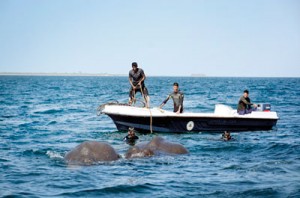News
Ocean-going jumbos possibly disoriented
View(s):Wildlife experts have not been able to adequately explain why a few elephants had been sighted in distress in the oceans closer to shore in the east and even in the deep seas. Some suspect they had been disoriented. Elephants are known to be able to negotiate lakes, reservoirs and rivers. Once again, this week, the navy helped to rescue two elephants seen in the waters off Trincomalee.

The rescue operation in progress
They had been detected by sailors on a patrol boat about one kilometre from shore near Round Island at about 6:30 am onSunday, July 30. A team of divers and three more fast attack craft were called in to guide the jumbos back to land. The divers secured a rope around the elephants to help drag them to shore.
The Department of Wildlife Conservation Trinco range office was also alerted to the incident. Around 11:40 am, the two elephants reached the shallow waters around Foul Point in Trincomalee. From there, the wildlife team took control and drove the elephants back to a nearby forest patch.
Trincomalee wildlife range officer, K A Srimal, said they were two young elephants and appeared to be in good health. Two weeks ago, the navy helped to pull to shore another elephant which had gone swimming.
On July 11, a lookout aboard a Dvora patrol craft saw an object about 8 nautical miles offshore from Kokkuthuduwai in Kokilai at about 9:00am, Lieutenant Commander MBC Perera later recalled. It turned out to be an elephant in distress. The rescue was complicated and dangerous and it took nearly 12 hours, ending only at late at night.
He recalled heavy rains at the time and rough seas.
Divers called to the scene took major risks trying to wrap a rope around the belly of the beast to help pull it to shore, slowly. Videos show that the creature appeared spent from struggling against strong currents and could not react aggressively to the human presence.
A navy diver did however recalled being struck by the struggling elephant’s foot and being pushed 10 feet under water as he attempted to cast a rope around the animal. It was about 4:00pmwhen the sailors began to haul the animal, stopping on occasions to allow it to catch up. When they reached the shallows, it was7:30 pm. Wildlife officers came in to help once the creature walked on to shore. The elephant was chased back in into the forest around Pulmuddai.
Wildlife ranger Mr Srimal said elephants had been seen in inland reservoirs such as Gal Oya, Udawalawe, and Maduru Oya.
There are also historical accounts of jumbos swimming on to islands in Trincomalee from the mainland.
Howard Martenstyn remembers seeing a swimming pachyderm back in the 1960s when one swam to Elephant Island from the Trinco dockyard area. Elephant researcher Dr Prithiviraj Fernando suspects that the elephant seen far from shore in the deep seas may have been disoriented and was dragged away by a strong ocean current.
He also remembers that in 2010, an elephant was seen in the seas near Norway Island off Sampur. It has been a translocated animal and had a radio collar. Dr Fernando believes it ended up in the sea in an attempt to find its way back to home. The elephant, named ‘Brigadier’ was found dead, later, having fallen into an abandoned agro-well.

